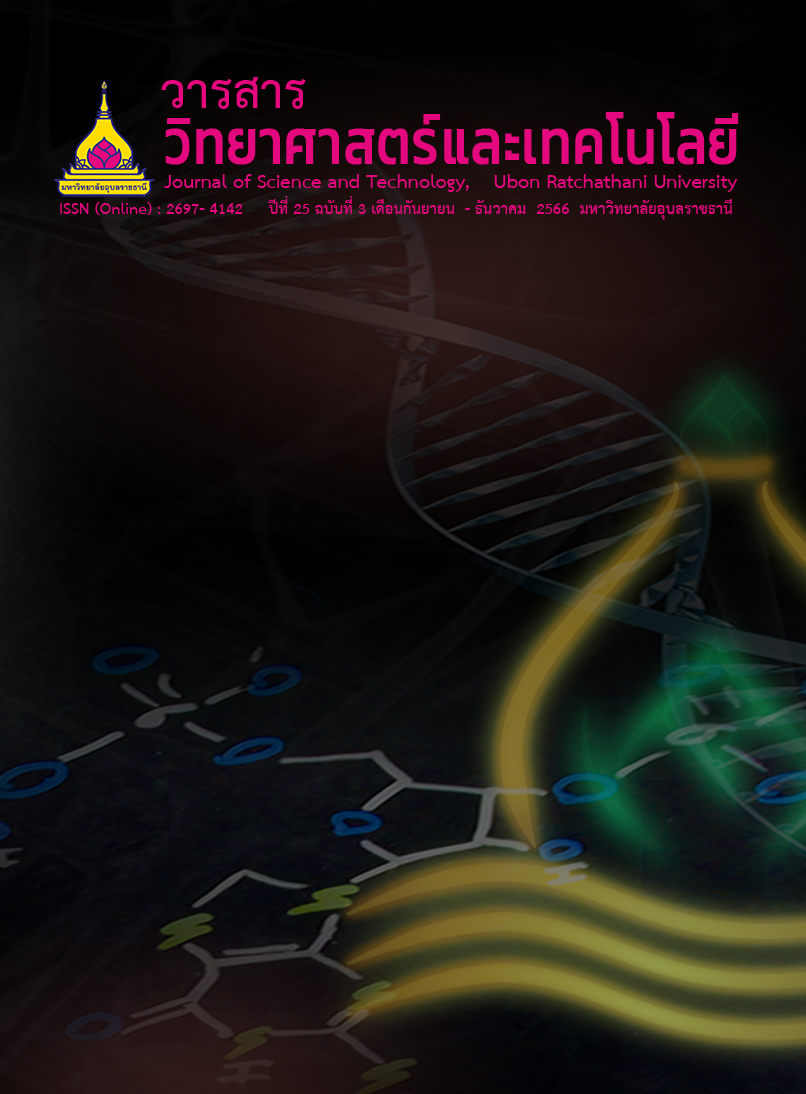การใช้เศษมวลรวมรีไซเคิลบดละเอียดเป็นวัสดุผสมเพิ่มร่วมกับเถ้าลอยในคอนกรีตไหลอัดแน่นด้วยตัวเอง
Main Article Content
บทคัดย่อ
งานวิจัยนี้มีวัตถุประสงค์เพื่อศึกษาคุณสมบัติของคอนกรีตไหลอัดแน่นด้วยตัวเองที่ใช้เศษมวลรวมรีไซเคิลบดละเอียดเป็นวัสดุผสมเพิ่มร่วมกับเถ้าลอย สำหรับคอนกรีตควบคุมใช้ปูนซีเมนต์ปอร์ตแลนด์ชนิดที่ 1 เป็นวัสดุประสาน และเถ้าลอยเป็นวัสดุผสมเพิ่มในอัตราส่วนร้อยละ 50 ต่อ 50 โดยน้ำหนัก ในการศึกษานี้ใช้เศษมวลรวมรีไซเคิลบดละเอียดแทนที่เถ้าลอยในอัตราส่วนร้อยละ 0, 25, 50, 75 และ 100 โดยน้ำหนัก กำหนดอัตราส่วนของน้ำต่อวัสดุประสานของทุกอัตราส่วนผสมเท่ากับ 0.38 ใช้สารลดน้ำพิเศษชนิดแนฟทาลีนเพื่อเพิ่มความสามารถทำงานได้ ทำการทดสอบคุณสมบัติของคอนกรีตไหลอัดแน่นด้วยตัวเอง ได้แก่ ความสามารถทำงานได้ การสูญเสียค่าการยุบตัว กำลังอัด กำลังดึงผ่าซีก และการทดสอบความเร็วของคลื่นความถี่สูงผ่านตัวอย่าง ผลการศึกษาแสดงให้เห็นว่าคอนกรีตไหลอัดแน่นด้วยตัวเองมีความหนืดที่สูงขึ้น มีการสูญเสียค่ายุบตัวอย่างที่รวดเร็วขึ้น และมีคุณสมบัติเชิงกลที่ลดลงตามปริมาณเศษมวลรวมรีไซเคิลบดละเอียดในส่วนผสมที่เพิ่มขึ้น อย่างไรก็ตามคอนกรีตไหลอัดแน่นด้วยตัวเองที่ใช้เศษคอนกรีตรีไซเคิลบดละเอียดร้อยละ 25 มีความสามารถทำงานที่ดี และมีค่ากำลังอัดที่อายุ 28 วัน มากกว่าร้อยละ 75 ของคอนกรีตควบคุม
Article Details

อนุญาตภายใต้เงื่อนไข Creative Commons Attribution-NonCommercial-NoDerivatives 4.0 International License.
บทความที่ได้รับการตีพิมพ์เป็นลิขสิทธิ์ของ วารสารวิทยาศาสตร์และเทคโนโลยี มหาวิทยาลัยอุบลราชธานี
ข้อความที่ปรากฏในบทความแต่ละเรื่องในวารสารวิชาการเล่มนี้เป็นความคิดเห็นส่วนตัวของผู้เขียนแต่ละท่านไม่เกี่ยวข้องกับมหาวิทยาลัยอุบลราชธานี และคณาจารย์ท่านอื่นๆในมหาวิทยาลัยฯ แต่อย่างใด ความรับผิดชอบองค์ประกอบทั้งหมดของบทความแต่ละเรื่องเป็นของผู้เขียนแต่ละท่าน หากมีความผิดพลาดใดๆ ผู้เขียนแต่ละท่านจะรับผิดชอบบทความของตนเองแต่ผู้เดียว
เอกสารอ้างอิง
Shi, C. and et al. 2015. A review on mixture design methods for self-compacting concrete. Construction and Building Materials. 84: 387-398.
Okamura, H. and Ouchi M. 2003. Self-compacting concrete. Journal of Advanced Concrete Technology. 1(1): 5-15.
Khatib, J.M. 2008. Performance of self-compacting concrete containing fly ash. Construction and Building Materials. 22(9): 1963-1971.
Zhao, H. and et al. 2015. The properties of the self-compacting concrete with fly ash and ground granulated blast furnace slag mineral admixtures. Journal of Cleaner Production. 95: 66-74.
Sasanipour, H., Aslani, F. and Taherinezhad, J. 2019. Effect of silica fume on durability of self-compacting concrete made with waste recycled concrete aggregates. Construction and Building Materials. 227: 1-12.
Chopra, D., Siddique, R. and Kunal. 2015. Strength, permeability and microstructure of self-compacting concrete containing rice husk ash. Biosystems Engineering. 130: 72-80.
Akram, T., Memon, S.A. and Obaid, H. 2009. Production of low cost self compacting concrete using bagasse ash. Construction and Building Materials. 23(2): 703-712.
Sua-Iam, G. and Makul, N. 2013. Incorporation of agricultural and industrial by-products in self-compacting concrete: A review. KMUTT Research & Development Journal. 36(4): 517-552. (in Thai)
Poon, C.S.Z., Shui, H. and Lam, L. 2004. Effect of microstructure of ITZ on compressive strength of concrete prepared with recycled aggregates. Construction and Building Materials. 18(6): 461-468.
Etxeberria, M., Mari, A.R. and Vazquez, E. 2007. Recycled aggregate concrete as structural material. Materials and Structures. 40(5): 529-541.
Sata, V., Wongsa, A. and Chindaprasirt, P. 2013. Properties of pervious geopolymer concrete using recycled aggregates. Construction and Building Materials. 42: 33-39.
Kim, Y.J. and Choi, Y.W. 2012. Utilization of waste concrete powder as a substitution material for cement. Construction and Building Materials. 30: 500-504.
Thailand Industrial Standards Institute (TISI). 2019. TIS 15-2562 (2019) Portland Cement. https://www3.tisi.go.th/hscode/hscode_view.asp?id=1. Accessed 8 January 2023. (in Thai)
ASTM International. 2018. ASTM 1611/C1611M -14 Standard Test Method for Slump Flow of Self-Consolidating Concrete. https://www.astm.org/c1611_c1611m-14.html. Accessed 12 January 2023.
European Federation of National Associations Representing for Concrete (EFNARC). 2002. Specification and Guidelines for Self-Compacting Concrete. https://wwwp.feb.unesp.br/pbastos/c.especiais/Efnarc.pdf. Accessed 15 January 2023.
ASTM International. 2021. ASTM C39/C39M-21 Standard Test Method for Compressive Strength of Cylindrical Concrete Specimens. https://www.astm.org/c0039_c0039m-21.html. Accessed 12 January 2023.
ASTM International. 2017. ASTM C496-96 Standard Test Method for Splitting Tensile Strength of Cylindrical Concrete Specimens. https://www.astm.org/c0496-96.html. Accessed 12 January 2023.
ASTM International. 2016. ASTM C597-16 Standard Test Method for Pulse Velocity Through Concrete. https://www.astm.org/c0597-16.html. Accessed 12 January 2023.
Chindaprasirt, P., Homwuttiwong, S. and Sirivivatnanon, V. 2004. Influence of fly ash fineness on strength, drying shrinkage and sulfate resistance of blended cement mortar. Cement and Concrete Research. 34(7): 1087-1092.
Xie, J. and Kayali, O. 2016. Effect of superplasticiser on workability enhancement of Class F and Class C fly ash-based geopolymers. Construction and Building Materials. 122: 36-42.
Chindaprasirt, P. and Jatuarpitakkul, C. 2006. Cement, Pozzolan and Concrete. 1st edition. Bangkok: Thailand Concrete Association. (in Thai)
Pensuwan, B. and et al. 2021. Effect of calcium carbonate powder on flowing performances and compressive strength of lightweight aggregate self-compacting concrete (LWASCC). Vocational Education Innovation and Research Journal. 5(2): 21-30. (in Thai)
Nasaeng, P. and Yuwanasiri, C. 2014. Effects of fly ash mixed with calcium carbide residue and ground bagasse ash content as filler on the properties of self-compacting concrete. In: Proceedings of the 2nd National and International Conference Northeastern University, 24 May 2014. Khon Kaen, Thailand. (in Thai)
Lao-unand, J. and et al. 2022. Use of car broken glass as fine aggregate in mortar. Engineering Journal of Research and Development. 33(3): 47-57. (in Thai)


